Forklift :
A forklift is also known as a lift truck essentially because it’s a truck that can lift loads using a set of forks. A forklift can be used in numerous places such as warehouses, factories, farms, shipping yards and much more. There are many types of forklifts which can be called a variety of different names; in this case we will use the basic names of the forklifts when describing their capabilities.
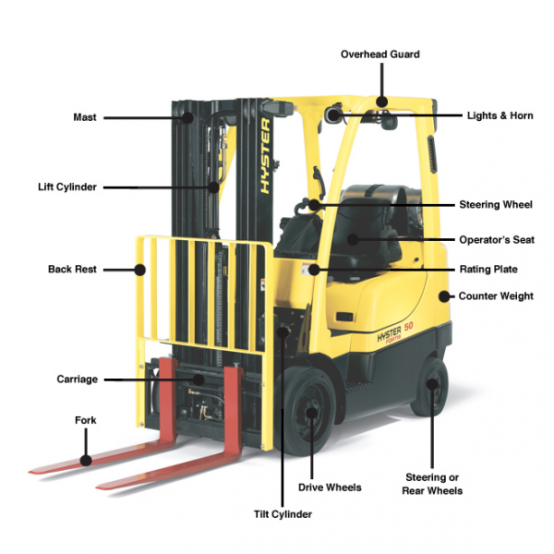
- Mast: The mast is the vertical support that permits raising and lowering the load.
- Carriage: A support structure where the forks are attached or mounted.
- Back Rest: Attached to the carriage and prevents the load shifting backwards, it protects the mast cylinders hoses as well as preventing any goods falling through the mast and hitting the operator.
- Fork (Tynes): The cantilevered arms attached to the load carriage, that engage the load.
- Lift Cylinder: Controls the amount by which the mast structure, forks and carriage may be raised or lowered in the vertical.
- Overhead Guard: A framework/roof, providing overhead protection for the operator from falling objects.
- Tilt Cylinder: Controls the amount by which the mast structure, forks and carriage may be tilted beyond the vertical position, forward or backward.
- Rating Plate: This is used to inform users of the maximum load a forklift can legally carry.
- Counter Weight: The weight installed by the manufacturer to give stability to the machine under load.
Types of Forklifts:
- Industrial Reach Forklift Trucks
- Industrial Counterbalance Forklifts
- Rough Terrain Forklifts
- Industrial Side Loader Forklifts
- Telescopic Handler Forklifts
- Pedestrian Operated Pallet Trucks
Industrial Reach Forklift Trucks:
 Industrial reach forklift truckare renowned for their extended lift height, making them ideal in any warehousing situation with high rise storage pallet racking. There are different types of reach forklift truck that are best suited to a range of scenarios:
Industrial reach forklift truckare renowned for their extended lift height, making them ideal in any warehousing situation with high rise storage pallet racking. There are different types of reach forklift truck that are best suited to a range of scenarios:
Stand-up trucks are the most common and are often used where there’s only one load per bay. The two forks on the front of the truck slide underneath palletised loads, to lift and transport safely.
Double-deep trucks are similar, but with longer forks, making them perfect for areas where multiple pallet loads are stored in each bay as they will reach right to the back of the bay. Straddle trucks also have long forks to slide under the load, while they also have the ability to grip onto the edges for increased stability and ease of access. This is ideal if you have multiple loads in one bay that you can access from different angles, as the truck can grab loads further back.
Industrial Counterbalance Forklifts:
 Industrial counterbalance forklifts are the most common trucks used in indoor warehouses and stores, although they can be used outdoors, on stable, even surfaces. They offer straightforward operation and have dual forks at the front of the truck that lift and transport the loads.
Industrial counterbalance forklifts are the most common trucks used in indoor warehouses and stores, although they can be used outdoors, on stable, even surfaces. They offer straightforward operation and have dual forks at the front of the truck that lift and transport the loads.
There are different types available, including three-wheel models that provide better manoeuvrability, making them perfect for narrow aisles.
Rough Terrain Forklifts:
 For outdoor construction and with difficult terrain, a rough terrain forklift is ideal. It has inflatable tyres with thicker threads, allowing stability on uneven ground, as well as a more powerful engine so it can reach higher speeds, and better manoeuvrability, making them must more robust and durable.
For outdoor construction and with difficult terrain, a rough terrain forklift is ideal. It has inflatable tyres with thicker threads, allowing stability on uneven ground, as well as a more powerful engine so it can reach higher speeds, and better manoeuvrability, making them must more robust and durable.
This means that they are perfect for transporting heavy loads across rugged terrain, with some models handling up to 3 tonnes per load. The carefully calibrated counterbalance at the back of the truck prevents overbalancing, with it being easily operated in mud, ice or even snow.
Industrial Side Loader Forklifts:

Side loader forklift trucks are ideally suited to working in narrow aisles. This is because the forks are mounted to the side of the truck and can pick up wide or long loads that would be awkward or inaccessible with a straight forward forklift.
There are two main types of side loader forklifts, the enclosed cab that is most commonly used outdoors, and a stand up version that is more suited to indoor tasks. There’s also a multi-way version, where the wheels all rotate by 90°, allowing ease of transportation in any direction.As a result, they are especially useful for lifting and transporting tubing, pipes and sheet materials safely and efficiently.
Telescopic Handler Forklifts:
 Telescopic handler forklifts are ideal for use in agriculture and all kinds of industry that require high lifting. They offer a whole range of features that make them much more useful in a range of situations, so much so that they are often thought of as small cranes, rather than forklift trucks.
Telescopic handler forklifts are ideal for use in agriculture and all kinds of industry that require high lifting. They offer a whole range of features that make them much more useful in a range of situations, so much so that they are often thought of as small cranes, rather than forklift trucks.
Telescopic handlers have the additional advantageof a single telescopic boom that allows the truck to become a much more powerful and flexible piece of machinery. There are a number of practical attachments available, including a lift table, bucket, pallet fork and muck grabber.
These attachments, and the ability to extend the lifting capabilities with front outriggers, enable the tele-handler to complete work at heights that normal forklifts can’t reach.
Pedestrian Operated Pallet Trucks:
 Pedestrian operated lift trucks and pallet trucks are most commonly used in warehouses and storage facilities for the easy transportation of pallets. All pedestrian operated trucks have forks that slide beneath the pallet and use a hydraulic jack to lift the load from the ground for easy manoeuvrability.
Pedestrian operated lift trucks and pallet trucks are most commonly used in warehouses and storage facilities for the easy transportation of pallets. All pedestrian operated trucks have forks that slide beneath the pallet and use a hydraulic jack to lift the load from the ground for easy manoeuvrability.
There’s a wide variety of styles and designs available, some capable of moving loads of 5000lbs, but the main difference is between the lift and pallet trucks.
The pallet truck is simply for moving loads from one place to another at ground level, but it has limited reach, while the lift truck is more complex and is capable of transporting and lifting a palletised load onto a higher level or for stacking loads on top of each other.
Identify Operators & Equipment
Operators- Anyone who is expected to ever operate a forklift or other "Powered Industrial Truck" such as man lifts, pallet jacks, etc., must be training and certified as an operator.
Equipment - There are many different types of powered industrial trucks. Typically, these types of vehicles are known as forklifts or lift trucks. If your employees will be expected to operate several different types of powered industrial trucks, then training is required on the unique handling characteristics of the vehicles.
Operator inspect during the visual pre-use check:
- General condition and cleanliness.
- Floor - clear of objects that could cause an accident.
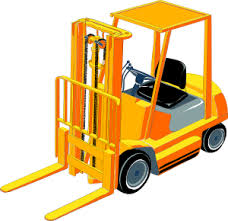
- Overhead - no obstructions.
- Nearby objects to avoid as you drive away.
- Fire extinguisher - present and charged.
- Engine oil level, fuel level, radiator water level (LPG, gas and diesel forklifts).
- Battery - fully charged; no exposed wires; plug connections not loose, worn or dirty; vent caps not clogged; electrolyte levels in cells is adequate; secured in place by hold downs or brackets.
- Bolts, nuts, guards, chains, or hydraulic hose reels not damaged, missing or loose.
- Wheels and tires - check for wear, damage, and air pressure, if pneumatic tires.
- Forks - forks not bent; no cracks present; positioning latches in good working condition;
- carriage teeth not broken, chipped or worn.
- Chain anchor pins - not worn, loose or bent.
- Fluid leaks - no damp spots or drips.
- Hoses - held securely; not loose, crimped, worn or rubbing.
- Horn - working and loud enough to be heard in working environment; other warning devices operational.
- Seatbelt and/or operator restraint device (if equipped) - belts and restraints work properly; no visible wear or damage; anchors, buckles, etc. function properly.
- Overhead guard - no damaged areas.
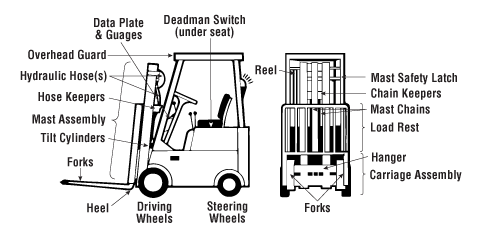
Inspection during the operational pre-use check:
- Foot Brake - pedal holds, unit stops smoothly.
- Parking Brake - holds against slight acceleration.
- Deadman Seat Brake - holds when operator rises from seat.
- Clutch and Gearshift - shifts smoothly with no jumping or jerking.
- Dash Control Panel - all lights and gauges are operational.
- Steering - moves smoothly.
- Lift Mechanism - operates smoothly (check by raising forks to maximum height then lowering forks completely).
- Tilt Mechanism - moves smoothly, holds (check by tilting mast all the way forward and backward).
- Cylinders and Hoses - not leaking after above checks.
- Listen for any unusual sounds or noises.
- Lights - headlights and warning lights are operational.
Report any problems identified in daily check to the supervisor immediately.
Behavioral and operational factors can contribute to forklift trucks accidents:
- Traveling at excessive speed.
- Riding with the load elevated.
- Improper backing up techniques.
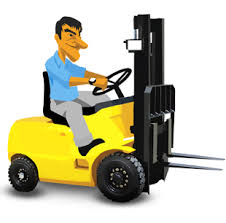
- Improper turning, breaking or accelerating.
- Improper warnings to others about a forklift in use nearby.
- Poor communication during shared tasks, or in shared spaces.
- Riding or giving rides on forklift or load.
- Parking the forklift improperly.
- Improper blocking of wheels on semi-trailers or railway cars.
- Horseplay; stunt driving; jerky, erratic driving.
- Inadequate servicing of the forklift.
Workplace design contribute to forklift trucks accidents:
- Narrow aisles.
- Crowded, cluttered aisles.
- Obstructions at intersections and doors.
- Volume of traffic in work area.
- Walking and working in the general area of forklift operations.
- Other workplace conditions such as noise, odours, toxic gases, dust, or poor lighting.
- Many ramps with different surfaces.
- Condition of loading dock.
Characteristics of the load create a hazard:
- Poorly stacked or piled on the pallet.
- Pallets in poor repair.
- Load too heavy.
- Load unstable or blocking vision.
Design features increase the risk for forklift accidents:
- Malfunction of brakes.
- Malfunction of steering.
- Malfunction of clutch, shift linkage, or transmission.
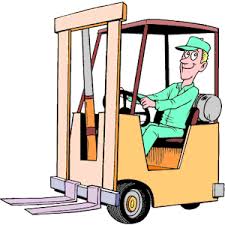
- Malfunction of mast assembly.
- Leaks in hydraulic systems or transmission.
- Safety devices lacking, inadequate, or malfunctioning.
- Emissions from forklifts.
- Blind spots or obstructions blocking driver's view.\
- Poor layout of controls and displays.
Important points of a periodical (six months) fork inspection:
- Check fork blades for wear. Forks are constantly subjected to abrasion by concrete floors, steel shelving, etc. This abrasion can reduce the thickness of a fork until it cannot lift loads up to the designed capacity.
- Check for distortion. Forks can be bent out of shape. Depending on distortion, some forks can be straightened. The fork manufacturer is best qualified to correct this. Your local forklift supplier can make the arrangements.
- Check for cracks in heel and hanger. Cracks may appear on forks where attachments are welded on or in the inside radius of the bend area. Periodic inspection using a magnetic particle or dye penetrant test can detect cracks. Approved grinding methods may grind out and polish these blemishes, depending on the depth of the crack. Contact your forklift supplier or the manufacturer for additional information.
- Replace, when necessary, with good quality forks. When ordering or reordering forks, make sure you are getting high quality forks that will do your lifting jobs safely. Insist on forged forks or ones with an upset heel.
- Use the proper forks. Custom-designed forks may be needed for:
- unusual lifting conditions
- spark-free areas
- high heat furnace areas
- special object lifting
- Contact your forklift supplier for assistance.

Load the forklift truck:
- Do not exceed the recommended load limit of your lift truck. Each lift truck has a maximum load limit. The load limit is shown on the data plate of the lift truck.
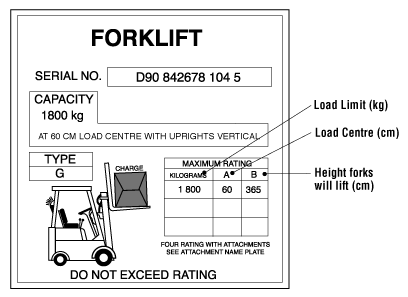
- Position the load according to the recommended load centre. The load limit of the lift truck decreases as the load centre is raised.
- Do not add extra weight to counterbalance an overload.
- Keep loads close to the front wheels to keep lift truck stable

Insert the fork when loading the forklift truck:
- Keep the mast of the forklift in an upright position before inserting the forks into a pallet
- Level the fork before inserting it into the pallet.
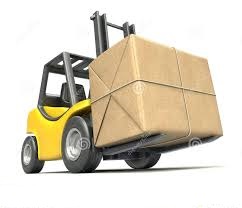
- Insert the fork all the way under the load (use forks that are at least two-thirds of the load length).
- Adjust the fork as wide as possible to fit the load and to provide a more even distribution of weight.
- Space the fork evenly from the center stringer of the pallet to balance the load.
- Do not protrude the fork past the back of a pallet when stacking in tight areas.
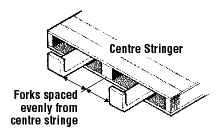
- Ensure that the load is secured before moving. If it is not, pile the load again or strap the load to skid.
- Ensure that loads on pallets are stable, neat, cross-tied if possible, and evenly distributed.
- Remove damaged pallets from service.
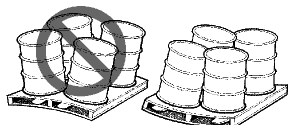
Load (unload) vehicles using a forklift truck?
- Keep forks pointed downhill when traveling without a load on a ramp.
- Keep forks pointed uphill when traveling with a load on a ramp.
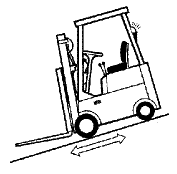

- Stay clear of edges of docks, rail cars or ramps. Have edges clearly marked.
- Do not tow or push railway cars or trucks with a forklift.
- Do not operate forklifts inside vehicles for long periods without ventilation.
- Make sure that the dock plate is properly secured and can support the load before driving over it. (Load weight should be clearly marked.)
- Drive carefully and slowly over the plate. Do not spin wheels.
When loading railway cars, what is important to know:
- Cross railway track on a diagonal.
- Set handbrakes, wheel blocks and derailer before entering a railway car.
- Do not park a forklift within three meters of railway tracks.
- Do not open railway car doors with forklift forks.
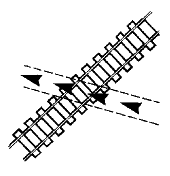
Maintain control when traveling:
- Tilt loads backwards.
- Travel with forks as low as possible from the floor and tilted back (maximum 10cm/4" above the floor).
- Match speed to driving, load and workplace conditions.
- Obey posted traffic signs.
- Decrease speed at all corners, sound horn and watch the swing of both the rear of the lift truck and the load.
- Watch for pedestrians.
- Avoid sudden stops.
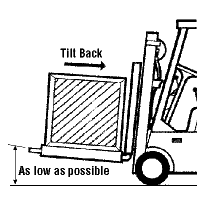
- Travel in reverse when a load blocks your vision and always look in the direction of travel.
- Check for adequate overhead clearance when entering an area or when raising the forks.
- Watch out for the following dangers on the floor or roadway: oil spots, wet spots, loose objects, or holes, rough surfaces, people, and other vehicles.
- Approach at an angle when crossing railroad tracks.
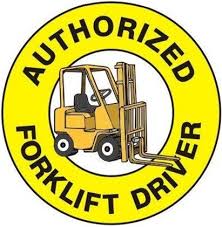
- Maintain a safe working limit from all overhead power lines.
- Do not turn on ramps.
- Do not elevate the load when the forklift truck is on an incline.
How should you steer to maintain control:
- Have the load carried by the front wheels.
- Turn with the rear wheels.
- Do not turn a lift truck steering wheel sharply at fast speeds.
- Do not overload a lift truck. It can cause a loss of steering control.
- Do not add extra weight to a counterweight to improve steering.

Safety procedures should you follow when servicing a forklift truck:
- Permit only qualified persons to service and maintain equipment.
- Wear proper personal protective equipment. Wear goggles when grinding. Wear face shields (with safety goggles), aprons, gloves and rubber boots when handling lead-acid batteries or working around battery-charging equipment. Wear leather gloves when changing LPG fuel tanks.
- Disconnect all batteries before doing any work.
- Before servicing LPG forklifts:
- Shut off the tank fuel valve.
- Run the engine until it stops.
- Disconnect the tank from the hose.
- Block the forklift securely when removing wheels.
- Support the forklift hood in upright position or remove to do work.
- Keep the work area clean and well lit.
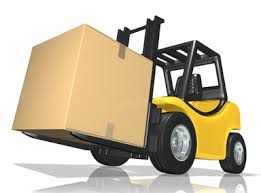
- Clean spilled oil or hydraulic fluid immediately.
- Check all tools before using.
- Remove all tools and parts before starting the engine.
- Handle batteries with care.
- Avoid contact with battery terminals with hoisting chains, tools and metal objects.
- Cover the battery top with some insulating material.
- Attach a chain hoist to the counterweight before removing it from a forklift.
- Check the bolts holding the counterweight to the body and replace any worn or missing bolts.
- Find out why a forklift is in for repairs before starting or driving it.
- Check the operator's daily checklist before making repairs.
- Inspect by magnetic particle testing the main mast welds and forks annually or when cracks appear.
- Inspect by magnetic particle testing all hoses, couplings, fittings and connections to the cylinders in the main mast assembly and the tilt control system.
- Inspect forks for distorted, twisted or bent sections. If defects are found, test the area of concern.
Operators follow when changing fuel tanks:
Procedure for changing propane (LPG) cylinders:
- Wear eye protection and insulated, loose fitting gloves such as leather (dry) or insulated neoprene.
- Close the valve on the cylinder.
- Run the engine until it stops. This ensures that the connection hose is empty.
- Shut off the engine.
- Open the connecting nut and inspect valves for leaking. Do NOT use metal tools.
- Disconnect the hose.
- Disconnect the holding straps.
- Remove the empty cylinder.
- Replace with a full cylinder in the proper position.
- Connect the holding straps.
- Tighten the connecting nut (wiggle hose).
- Open the valve on the cylinder slowly and check for leaks. Use solution of soap and water. Smell – listen – look.
- If the valve leaks:
- 1st time - Tighten the nut and continue.
- 2nd time - Change the cylinder.
- 3rd time - Change the hose.
- Open the valve fully (slowly).
- Check that the hose is turned inward.
- Secure the hose downward.
- Secure the cylinder.
- Start the engine and resume operation.
Click the below link to download the forklift guidelines and check sheet

Forklift daily safety check sheet